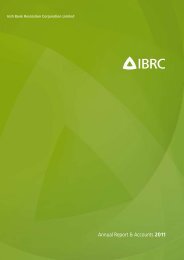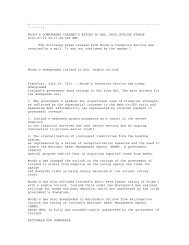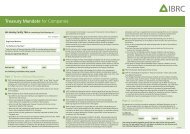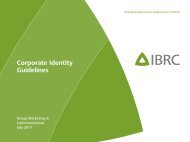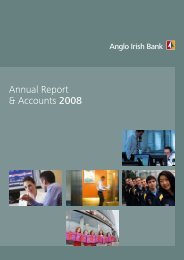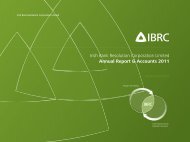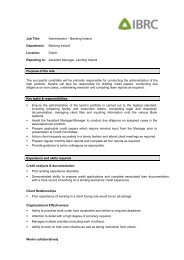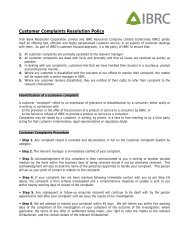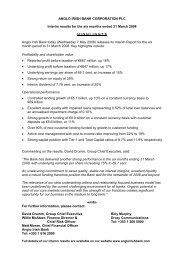Annual Report & Accounts 2009 - Anglo Irish Bank
Annual Report & Accounts 2009 - Anglo Irish Bank
Annual Report & Accounts 2009 - Anglo Irish Bank
You also want an ePaper? Increase the reach of your titles
YUMPU automatically turns print PDFs into web optimized ePapers that Google loves.
Notes to the financial statements continued<br />
1. General information and accounting policies continued<br />
1.11 Impairment of financial assets continued<br />
The Group first assesses whether objective evidence of impairment exists individually for financial assets that are individually significant,<br />
and individually or collectively for financial assets that are not individually significant. If the Group determines that no objective evidence<br />
of impairment exists for an individually assessed financial asset, whether significant or not, it includes that asset in a group of financial<br />
assets with similar credit risk characteristics and includes these performing assets under the collective incurred but not reported ('IBNR')<br />
assessment. An IBNR impairment provision represents an interim step pending the identification of impairment losses on an individual<br />
asset in a group of financial assets. As soon as information is available that specifically identifies losses on individually impaired assets in a<br />
group, those assets are removed from the group. Assets that are individually assessed for impairment and for which an impairment loss<br />
is, or continues to be, recognised are not included under the collective assessment of impairment.<br />
For loans and receivables and held-to-maturity investments, the amount of impairment loss is measured as the difference between the<br />
asset's carrying amount and the present value of estimated future cash flows discounted at the asset's original effective interest rate. If a<br />
loan or held-to-maturity investment has a variable interest rate, the discount rate for measuring any impairment loss is the current<br />
effective interest rate determined under the contract. The amount of the loss is recognised using an allowance account and is included in<br />
the income statement.<br />
The calculation of the present value of the estimated future cash flows of a collateralised financial asset reflects the cash flows that may<br />
result from foreclosure, less costs for obtaining and selling the collateral, whether or not foreclosure is probable.<br />
If, in a subsequent period, the amount of the impairment loss decreases and the decrease can be related objectively to an event<br />
occurring after the impairment was recognised, the previously recognised impairment loss is reversed by adjusting the allowance<br />
account. The amount of the reversal is recognised in profit or loss.<br />
When a borrower fails to make a contractually due payment of interest or principal but the Group believes that impairment is not<br />
appropriate on the basis of the level of security/collateral available and/or the stage of collections of amounts owed to the Group, a loan<br />
is classified as past due but not impaired. In this instance the entire exposure is reported as past due but not impaired, rather than just<br />
the amount in arrears.<br />
Renegotiated loans are those loans and receivables outstanding at the end of the reporting period whose terms have been renegotiated<br />
during the financial period, resulting in an upgrade from impaired to performing status. This is based on subsequent good performance<br />
and/or an improvement in the profile of the borrower.<br />
When a loan is deemed to be uncollectible, it is written off against the related provision for loan impairment. Such loans are written off<br />
after all the necessary procedures have been completed and the amount of the loss has been determined. Subsequent recoveries of<br />
amounts previously written off decrease the amount of the provision for loan impairment in the income statement.<br />
In the case of equity instruments classified as available-for-sale financial assets, a significant or prolonged decline in the fair value of the<br />
instrument below its cost is considered in determining whether impairment exists. Where such evidence exists, the cumulative net loss<br />
that has been previously recognised directly in equity is removed from equity and recognised in profit or loss. Impairment losses<br />
recognised in profit or loss on equity shares are not reversed through the income statement. All increases in the fair value of equity<br />
shares after impairment are recognised directly in equity.<br />
In the case of debt instruments classified as available-for-sale financial assets, impairment is assessed based on the same criteria as for all<br />
other financial assets. Impairment charges are made where there is objective evidence to suggest that the recovery value of the debt<br />
instrument will be permanently lower than its cost. A significant or prolonged decline in the fair value of such an instrument below its<br />
cost is considered in determining whether an impairment loss has been incurred. Other factors for asset backed securities (‘ABS’) include<br />
evidence of deterioration in the quantum or quality of the collateral pools underlying the investments and the non-payment or deferral of<br />
interest. Reversals of impairments of debt securities are recognised in profit or loss if the increase in fair value can be objectively related<br />
to an event occurring after the impairment loss was recognised.<br />
1.12 Derivative financial instruments and hedge accounting<br />
Derivatives<br />
Derivative instruments, including swaps, futures, forward foreign exchange contracts, forward rate agreements and options, are used for<br />
trading and for hedging purposes.<br />
Derivatives are initially recognised at fair value on the date on which a derivative contract is entered into and are subsequently<br />
remeasured at their fair value. Fair values are obtained from quoted market prices in active markets and where these are not available<br />
from valuation techniques including discounted cash flow and option pricing models. Fair values are adjusted for counterparty credit risk.<br />
All derivatives are carried as assets when their fair value is positive and as liabilities when their fair value is negative. Derivatives are<br />
classified as held for trading unless they are designated as hedges.<br />
Hedge accounting<br />
The method of recognising the resulting fair value gain or loss depends on whether the derivative is designated as a hedging instrument,<br />
and if so, the nature of the item being hedged. The Group designates certain derivatives as either fair value hedges (where the Group<br />
hedges changes in the fair value of recognised assets or liabilities or firm commitments), cash flow hedges (where the Group hedges the<br />
exposure to variability of cash flows attributable to recognised assets or liabilities or highly probable forecasted transactions) or hedges<br />
of a net investment in a foreign currency operation.<br />
50



